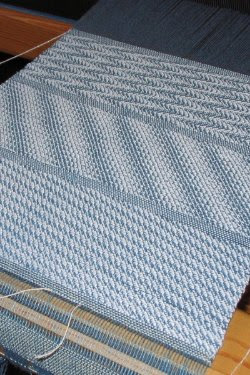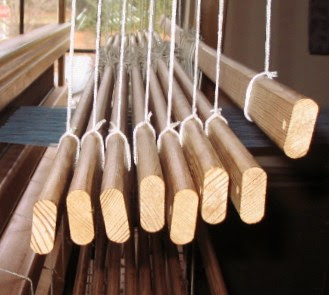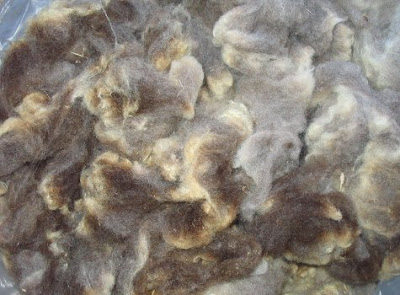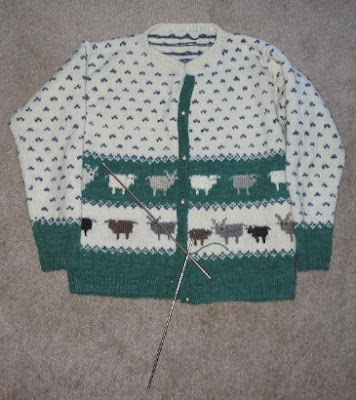By
LeighEven if you aren't a weaver, you are familiar with twills. Blue jeans are made from twill fabric. You've probably heard of Herringbone Tweed, which is a twill fabric. My
zig zag afghans are all twill weaves. After plain weave, it is probably the most common weave structure there is, and is usually the second structure new weavers learn.
The
Online Guild is finishing up it's Advancing Twills workshop this month. I've had a lot of other goings on, but have been able to read through the workshop notes and start on some advancing twill drafts.
I have found that even though I have woven quite a few samplers and projects in twill, I am still usually unable to readily conjure up an image when terms like "extended point" or "rosepath" are tossed about, let alone "advancing twills". I think that this is because usually, I just follow a draft. When I'm done, I love the results, but can't say that I really understand it. I think this has been especially true of twills for me, because there are so many variations and ways to change them.
So before I got on with the advancing twills, I reckoned it would be good to go back and study the basics first. I find that when I attempt to explain something to someone else (in this case, you all!), it forces me to go beyond a superficial or passing grasp of the subject. In order to put it into my own words, I have to begin to understand the concept behind the terms. I'm hoping that this post will help me do that.

Twills are easily recognizable because they contain diagonals. Looking closely, the diagonals are like stair steps, with every step having at least one warp thread in common with its neighbours.
The sample on the left is a simple, straight, 2/2 twill. This means that the weft thread travels over two warp threads, then under two.
There are four basic categories of twills: straight, point, extended point, and broken. I'm going to focus on the threading patterns for each of these.
Straight Twills
The threading moves in one direction because the shafts are threaded successively; 1 through 4, or 1 through 8, etc. It can go to the left, or the right, as long as it is consistent.
Point Twills
These reverse directions, ending on the same shaft they start on. It isn't limited to the number of shafts one has, and can extend beyond them like this,

as long as the starting and reverse points always occur on the same shafts.
Rosepath
is an point twill which is extended one thread more than the number of shafts available. I've included this one because I hear it referred to often, but have never been able to remember the draft when I hear it mentioned.
Extended Point Twills
combine sections of straight twill with point twill. Unlike point twills, in which the direction changes only once before returning to the starting point, extended point twills can change direction more than once.
Broken Twills

have a "break" in the threading. In other words, some shafts are omitted. Rather than having a successive threading order, their threading order has skips in it.
There are other types of twill, but these are the basic ones. If I can just get them to stick in my head I'll be happy. Variations on any of these are endless. One can vary the threading, the treadling, the combination of shafts lifted (the tie-up), the type and size of yarns, sett, or the colors used. The number of warp threads the weft goes over and under can be varied. The warp can dominate the pattern, or the weft can.
So there you have it. Oddly, no one book of mine had a straightforward, complete definition for them all(!) Not sure why; perhaps each author simply puts down the most important feature to them. At any rate, here are the sources I used:
Advancing Twill OLG Workshop notes, by Stacey Harvey-Brown,
The Loom Room, Staffordshire, UK, 2007
The Complete Book of Drafting for Handweavers by Madelyn van der Hoogt, Unicorn Books and Crafts, Inc., Petluma, CA, 1993
Eight Shafts A Place to Begin by Wanda Jean Shelp and Carolyn Wostenberg, self-published by Wanda J. Shelp, Worland, WY, 1991
The Weaving Book by Helene Bress, Charles Scribner's Sons, New York, 1981
Next I'll try to explain what an advancing twill is.
Click here to go on to that.
Related Posts:
Advancing Twills - A Simple DefinitionMystery of the Zig Zag Twills - Lining up color stripes with twill threading
Waffle Weave - Another idea for twill threadings
 .... which have become three yarns....
.... which have become three yarns.... I didn't make extensive spinning notes on these, but I can tell you that the
black and grey are British Shetland. Their fibers measured five to six inches in
length. I got both of these from
Woodland Woolworks. The black had some interesting white fibers scattered here and there
throughout. I bought the moorit from
Paradise Fibers
(way back when Kate owned it) and it's fiber length averages four inches.
I didn't make extensive spinning notes on these, but I can tell you that the
black and grey are British Shetland. Their fibers measured five to six inches in
length. I got both of these from
Woodland Woolworks. The black had some interesting white fibers scattered here and there
throughout. I bought the moorit from
Paradise Fibers
(way back when Kate owned it) and it's fiber length averages four inches.












































